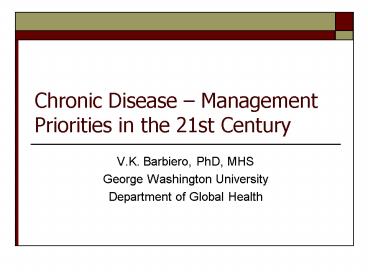Chronic Disease Management Priorities in the 21st Century - PowerPoint PPT Presentation
1 / 34
Title:
Chronic Disease Management Priorities in the 21st Century
Description:
... (stroke) Cancer. Chronic Respiratory Disease. Diabetes ... Diseases. Heart Disease. Stroke. Cancer. COPD. Diabetes. No Quick Fixes...No Magic Bullets... – PowerPoint PPT presentation
Number of Views:421
Avg rating:3.0/5.0
Title: Chronic Disease Management Priorities in the 21st Century
1
Chronic Disease Management Priorities in the
21st Century
- V.K. Barbiero, PhD, MHS
- George Washington University
- Department of Global Health
2
Setting the Stage
- Rememberaverages mean squat
3
Chronic Diseases
4
What Are Chronic Diseases
- Cardiovascular (heart disease) (hypertension)
- Cerebrovascular (stroke)
- Cancer
- Chronic Respiratory Disease
- Diabetes
- Mental disorders
- Oral disease
- Bone and joint
- Genetic disorders
5
Characteristics of Chronic Diseases
- Take time to become fully established
- Have origins at young ages
- Required long, systematic and often expensive
approaches to treatment - Require integration with responses to acute,
infectious diseases - Many opportunities for prevention
- They are the leading cause of death in all
regions except Africa
6
Eight Myths of Chronic Diseases
- Wait until infectious diseases are controlled
- Economic growth will improve all health
conditions - Chronic diseases affect only the affluent
- Chronic diseases are diseases of the elderly
- Chronic diseases result from individual behaviors
- Benefits of CD control are for individuals only
- ID models apply to chronic diseases
- Chronic diseases should only be addressed in the
health sector
Source Merson, et. al., 2005
7
The Demographic Transition
8
The Epidemiologic Transition
2005
Source Omran, A.R., 1971. The Epidemiologic
Transition.
9
The Nutrition Transition
- Pre-processed foods
- More food of animal origin
- Fall in cereal and fiber intake
- More sugar added to food
- More alcohol
- Urbanization
Source Popkin, BM, 2001. Journal of Nutrition
131871S-873S, 2001)
10
Pathways of the Nutrition Transition
11
Prevalence of Overweight (BMI 25) of Women by
Income Strata
Prevalence () of BMI 25
Source WHO, 2005
12
The Urban Transition
2008 World 50 Urban
13
Four Stages of The Health Transition
CVD Cardiovascular disease PVD peripheral
vascular disease
14
Ghanas Days of Healthy Live Lost
CHILDREN
Undernutrition DD, ARI
Malaria
Measles other Preventable
Non Preventable Childhood Deaths
Non Preventable Adult Deaths
Preventable Adult Deaths
ADULTS
Source Merson, et. al., 2005
15
Disability-Death Model
The Ideal
PYLLs, HeaLYs, QALYys, DALYs
Early Deaths
2007 Death/Disability
Mortality Death
2025 Disability/Death
Birth
90 Yrs
24-36 Months
High Case Fatality
Disability Death
Continuing Early Deaths
16
Population/Family Planning the Development
Imperative
Billions of People
17
Pyramids Tell the Tale
China 2000 2050 Population 1.42B
18
Pyramids Tell the Tale
Nigeria 2000 2050 Population 307M
19
Chronic Diseases - Fact Sheet
- 35 million will die from chronic diseases in 2005
- More people die from chronic diseases than
infectious diseases worldwide - 60 of all deaths are from chronic diseases
- 80 of chronic disease deaths occur in mid-low
income countries - 12 million die of heart attacks annually
- 50 of deaths are women
- 1 billion adults are overweight worldwide 30
obese - Behavioral interventions are effective
20
Global Chronic Disease Profile
Total Deaths 2005 58 Million
Source WHO, 2006
21
Estimated Causes of Death Worldwide
Total Deaths 2005 58 Million
Source WHO, 2002
22
Projections of Future Deaths
- There will be about 64 million deaths in 2015
- 17 million from communicable diseases
- 41 million from chronic diseases
- 6 million from injuries
- CVD and stroke will remain highest with 20
million
Source WHO, 2002
23
Estimated DALYs By Condition
Source WHO, 2002
24
The Double Burden for the Poor
25
Estimated Causes of Death by Income 2005
Age Standardized Death Rates Per 100,000
Source WHO, 2002, vkb/extrapolated from World
Bank graph
26
Estimated DALYs by Income
Source WHO, 2002, vkb/extrapolated from World
Bank graph
27
Elements Progression of Chronic Diseases
Modifiable Risk Factors Diet Activity Smoking
Underlying Social Environmental Determinants
Immediate Risk Factors
Main Chronic Diseases
Urbanization Aging Population
Non-Modifiable Risk Factors Age Heredity
Blood Pressure High Glucose Abdominal
Fat Overweight Obesity
Heart Disease Stroke Cancer COPD Diabetes
Source vkb adapted from WHO, 2002
28
No Quick FixesNo Magic Bullets
29
Preventing and Managing Chronic Disease
- Health Promotion (to shift distribution of risks)
- Specific Prevention Programs
- Diet, smoking, exercise
- Environmental and Occupational Exposures
- e.g. Sexual Health (AIDS, HPV, etc)
- Retooling Health Service Programs
- Health Impact of Non-Health Policy
- Food Safety
- Agriculture/Trade
- Urban Planning
30
Preventing and Managing Chronic Disease
- WHAT TO DO IS THE EASY PART
- HOW TO DO IT IS ANOTHER STORY
31
Policy to Action
- Talk is free
- Ink is cheap
- Action takes a lot of money, time, commitment and
effort
32
Lessons to Date
- HIV/AIDS Prevention, Care and Treatment
- Insurance Schemes and Tiered pricing
- Training and Task Shifting
- Level of training, brain drain
- DOTS and TB
- Diagnosis and treatment?
- Prevention?..blah, blah, blah
- do we know?...witness USAs BMI
- Facility care, HBC, palliative care?
33
Conclusions
- Chronic disease epidemiology is a worldwide issue
- We need more thought and demonstration
interventions on this issue - AIDS requires chronic disease managementwhat
lessons can we learn? - Double and triple burden of disease in LDCs will
cause millions to suffer - Action is requiredwe must beginnow
34
THANK YOU































